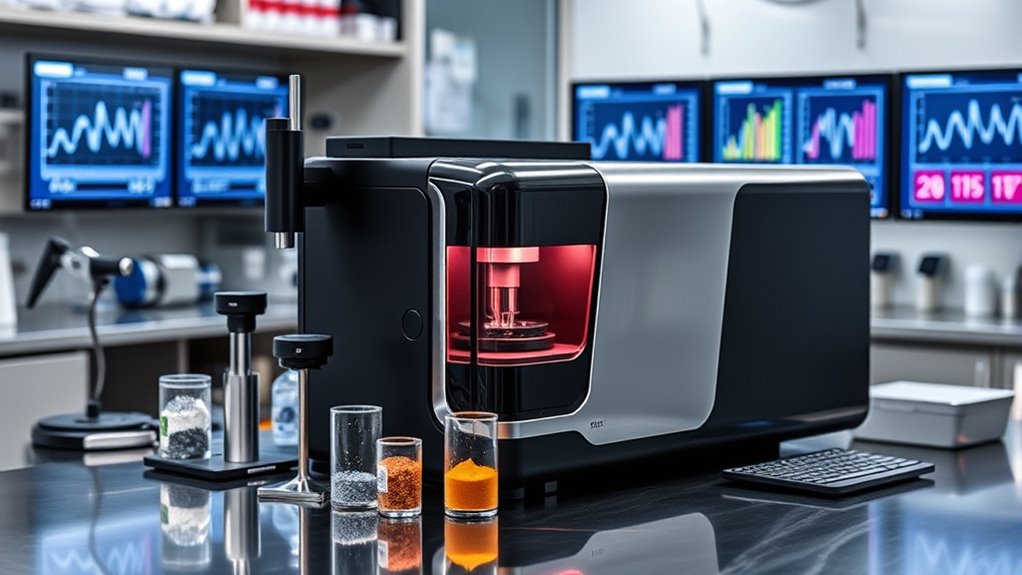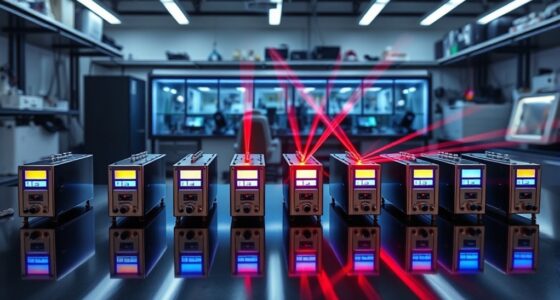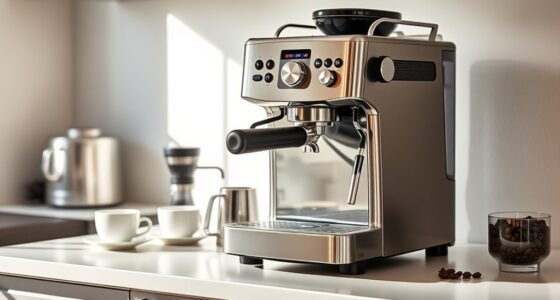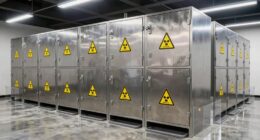If you’re looking for the 12 best laser particle size analyzers in 2025, I can guide you through top options that combine high precision, portability, and advanced detection technology. These include models like the Temtop PMD371, Dust Particle Counters, and industrial-grade analyzers, which are ideal for cleanrooms, labs, and air quality monitoring. Each offers features like real-time data, extensive storage, and robust construction. Stick around, and you’ll discover key details to help you choose the perfect device.
Key Takeaways
- Top analyzers feature high-precision laser scattering technology for particle detection from 0.3μm to 10μm.
- Many models support comprehensive metrics like PM2.5, AQI, temperature, and humidity for detailed analysis.
- Portable devices with rechargeable batteries and large data storage are ideal for field and industrial use.
- Advanced analyzers comply with ISO 21501 and NIST standards, ensuring measurement accuracy and reliability.
- Durability, ease of operation, and connectivity options make these analyzers suitable for various indoor and outdoor environments.
Smart 126s Indoor Air Quality Monitor
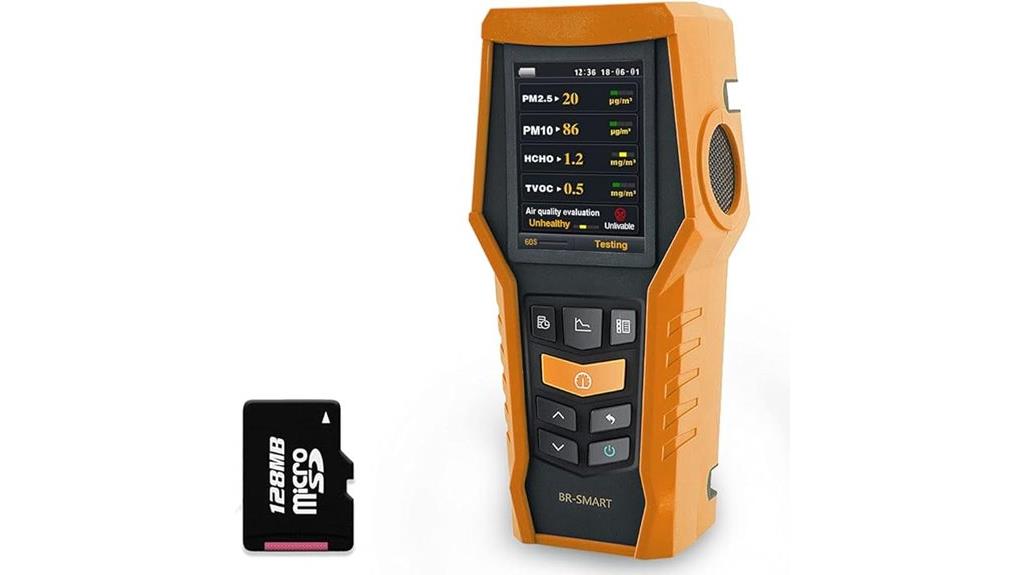
The Smart 126s Indoor Air Quality Monitor is an excellent choice for anyone looking to keep a close eye on their indoor environment, especially if you’re concerned about fine dust, VOCs, and formaldehyde. It measures PM1.0, PM2.5, PM10, TVOCs, and HCHO in real-time, using laser sensors and electrochemical detection for accuracy. The device logs data every minute, supporting up to 400 days of records with expandable storage. Its intuitive interface displays readings clearly, helping you identify pollution sources quickly. Although some users report limited battery life and setup issues, many find it valuable for ongoing air quality monitoring and health awareness.
Best For: individuals seeking affordable, real-time indoor air quality monitoring to detect dust, VOCs, and formaldehyde for health and safety awareness.
Pros:
- Supports comprehensive measurement of PM1.0, PM2.5, PM10, TVOCs, and HCHO with real-time data.
- Logs data continuously with expandable storage up to 8GB, enabling long-term tracking.
- User-friendly display and curve mode make it easy to interpret air quality levels at a glance.
Cons:
- Limited battery life, often less than an hour when fully charged, affecting portability.
- Setup and manual calibration can be confusing or inconsistent, leading to potential inaccuracies.
- Hardware reliability issues such as screen failure or malfunction after prolonged use have been reported.
Temtop Particle Counter Aerosol Dust Monitor with RS-485
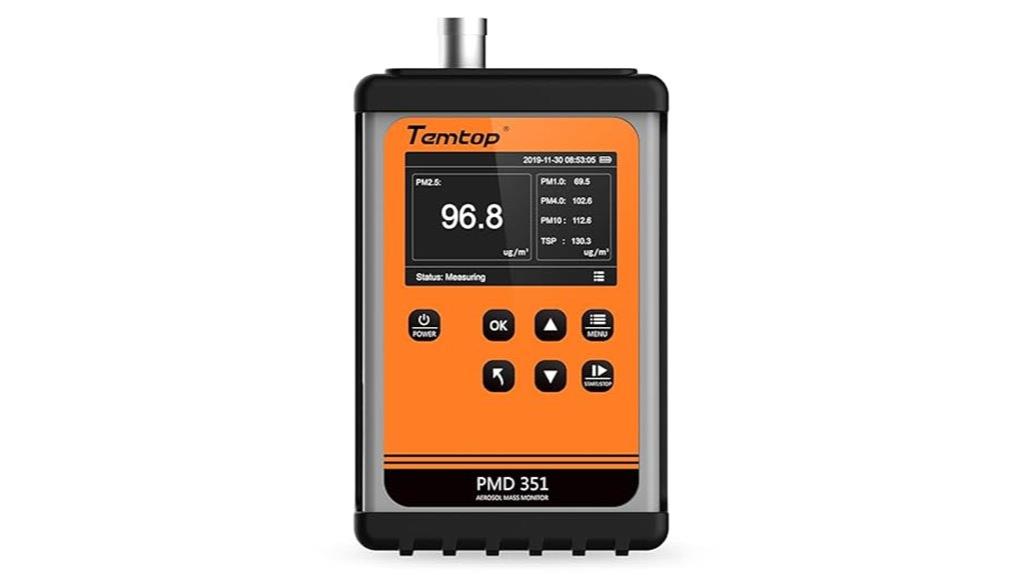
Looking for an aerosol dust monitor that combines precise particle measurement with reliable data transmission? The Temtop Particle Counter Aerosol Dust Monitor uses Mie scattering to accurately measure PM1, PM2.5, PM4, PM10, and TSP levels, providing detailed air quality data. Its large, easy-to-read display and 2 million data set storage make monitoring straightforward, with seamless data export via USB. The device’s built-in 2.83L/min pump and laser sensor ensure stable, dependable measurements even in demanding environments. Plus, its RS-485 support allows stable long-distance communication and multi-point system integration, making it ideal for complex industrial and environmental monitoring setups.
Best For: environmental professionals and industrial facilities seeking precise aerosol particle monitoring with reliable long-distance data transmission and comprehensive air quality analysis.
Pros:
- Accurate measurement of multiple particle sizes (PM1, PM2.5, PM4, PM10, TSP) using Mie scattering technology.
- Large 2 million data set storage capacity with easy USB data export for detailed analysis.
- Supports RS-485 communication for stable long-distance data transmission and multi-point system integration.
Cons:
- May require some technical knowledge for optimal setup and integration with existing systems.
- The device and accessories could be relatively costly compared to simpler air quality monitors.
- Limited details on battery life or portable operation, which might impact field use in some scenarios.
Temtop Handheld Particle Counter (PM2.5, PM10, TSP)
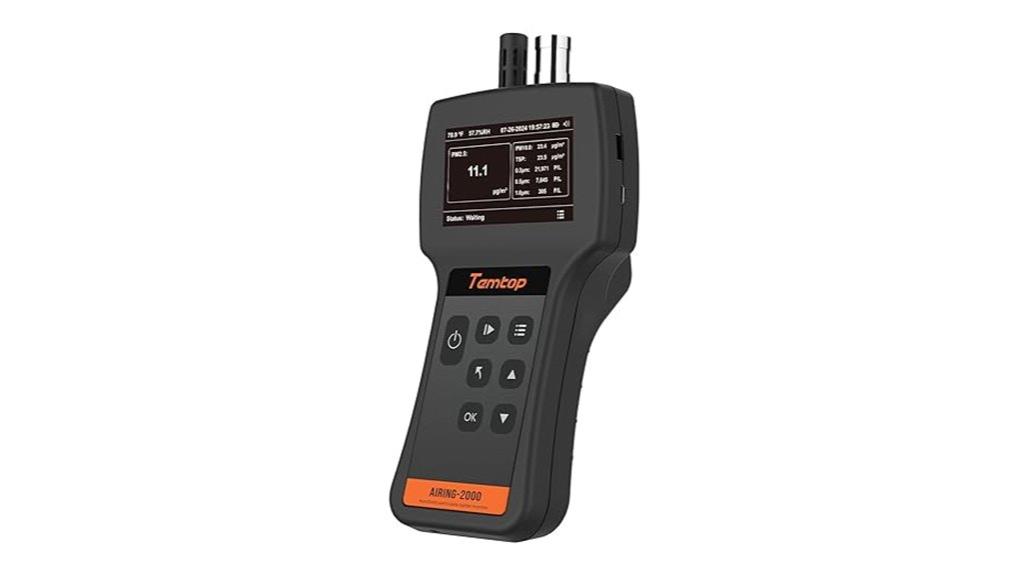
If you need a reliable, portable device for quick and accurate air quality assessments, the Temtop Handheld Particle Counter is an excellent choice. It measures particles as small as 0.3µm, including PM2.5, PM10, and TSP, providing precise indoor and outdoor air quality data. The device features a clear display, simple controls, and a rugged, lightweight design, making it ideal for field use. With a 3500mAh battery lasting over four hours and 32GB of internal storage, it supports extensive data logging. Equipped with temperature and humidity sensors, it offers a thorough environmental overview, though it doesn’t measure VOCs or formaldehyde.
Best For: individuals and professionals seeking a portable, accurate device for quick indoor and outdoor air quality assessments, especially during wildfire seasons, winter wood smoke, or summer emissions.
Pros:
- Precise measurement of particles 0.3µm, PM2.5, PM10, and TSP for reliable air quality data
- Rugged, lightweight design with a large display and simple controls for ease of use in the field
- Extended battery life of over four hours and substantial internal storage for comprehensive data logging
Cons:
- Does not measure VOCs or formaldehyde, limiting full indoor air quality evaluation
- Limited to particulate matter and environmental parameters; lacks chemical pollutant detection
- Continuous operation is limited to around four hours, which may require periodic recharging for longer monitoring sessions
Extech VPC260 6-Channel Particle Counter
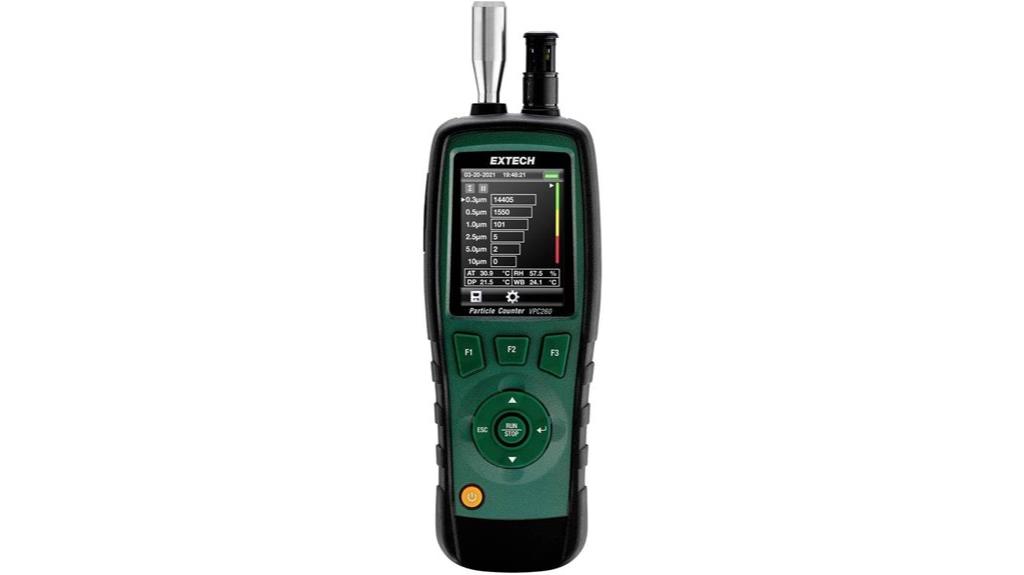
For professionals conducting indoor air quality assessments, the Extech VPC260 6-Channel Particle Counter stands out with its ability to simultaneously measure six particle size channels down to 0.3 μm, along with environmental parameters like temperature, humidity, dew point, and wet bulb. Its intuitive interface allows easy customization of display, sample methods, and alarms. With storage for up to 1,000 records, data logging is straightforward, and exporting data guarantees compliance and thorough documentation. Weighing just 15.8 ounces, it’s portable and ergonomic, perfect for field use. Its rechargeable battery and included accessories make it versatile for extended monitoring scenarios.
Best For: professionals and environmental specialists conducting comprehensive indoor air quality assessments in various settings.
Pros:
- Measures six particle size channels down to 0.3 μm simultaneously for detailed analysis.
- Stores up to 1,000 records with easy data export for documentation and compliance.
- Lightweight, ergonomic design with a rechargeable battery, ideal for portable field use.
Cons:
- May require familiarity with air quality monitoring to fully utilize advanced features.
- Limited to indoor environments; not suitable for outdoor or highly contaminated sites.
- The device’s feature set might be more than needed for casual or infrequent users.
Temtop Air Quality Monitor for Indoor/Outdoor Pollution Detection

The Temtop Air Quality Monitor stands out as an excellent choice for anyone needing accurate, real-time indoor and outdoor air quality data. It measures PM2.5, PM10, formaldehyde, temperature, humidity, and AQI, using pre-calibrated sensors and industrial-grade laser particle sensors with up to 20,000 hours lifespan. The device delivers fast, reliable readings displayed on a clear TFT screen, with health indicators and a stable kickstand. Data export allows for long-term trend analysis. While it lacks CO2 detection, its high accuracy—validated by AQMD tests—and user-friendly operation make it ideal for personal, indoor, and outdoor pollution monitoring.
Best For: individuals seeking accurate, real-time indoor and outdoor air quality monitoring for personal health, environmental awareness, or community data collection.
Pros:
- High accuracy validated by AQMD with R2 up to 0.999 and consistent outdoor/indoor readings
- All-in-one measurement of PM2.5, PM10, formaldehyde, temperature, humidity, and AQI with a clear TFT display
- Durable, industrial-grade sensors with up to 20,000 hours lifespan and easy data export for trend analysis
Cons:
- Does not include CO2 detection, limiting comprehensive indoor air quality assessment
- Sensitive to dust, mist, or visible particles, which can foul the laser sensors and affect accuracy
- Lacks internal calibration functions, requiring manual calibration or comparison over time for optimal performance
Laser Particle Counter (DC1100) – with Computer Interface
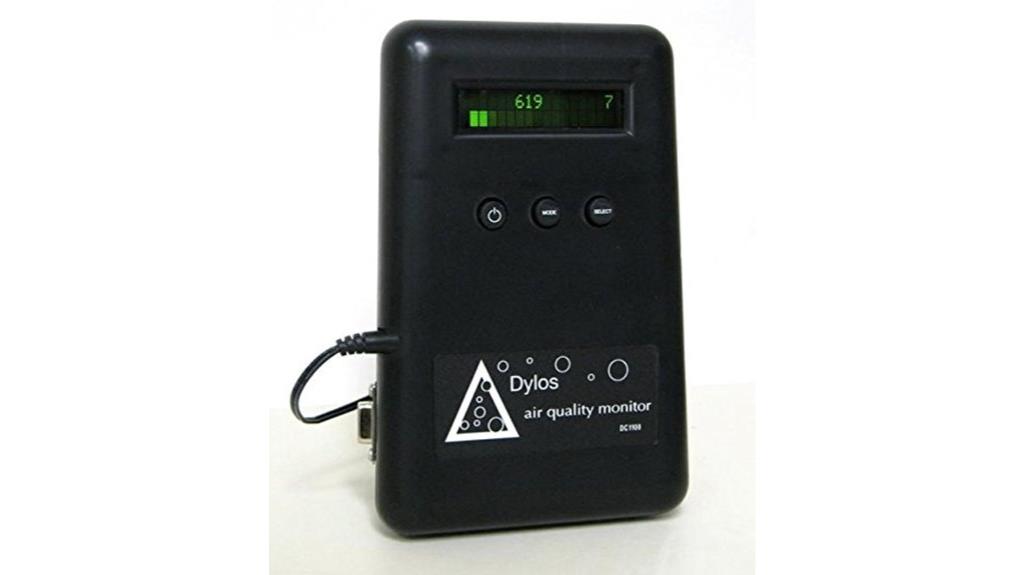
Looking for an easy way to monitor indoor air quality with reliable data? The Laser Particle Counter (DC1100) with Computer Interface is a straightforward, affordable option. It detects particles down to 1 micron and measures both small particles like bacteria and mold, and larger ones like pollen. With multiple modes—minute, hour, day, and continuous—it offers flexible monitoring. The device’s user-friendly interface makes it simple to operate, while the optional PC connection allows for detailed data analysis. Whether you want quick checks or in-depth insights, this counter helps you keep track of indoor air quality accurately and conveniently.
Best For: home users and consumers seeking an affordable, easy-to-use indoor air quality monitor with reliable particle detection and data analysis capabilities.
Pros:
- Accurate detection of particles as small as 1 micron, including bacteria, mold, and pollen
- Multiple measurement modes for flexible, continuous monitoring
- User-friendly interface with optional PC connectivity for detailed data analysis
Cons:
- Standard model includes PC interface but lacks advanced features found in pro versions
- May require additional equipment or software for in-depth data analysis
- Designed primarily for consumer use, potentially limiting professional or industrial applications
CEM T.ax Particle Counter with TFT Display and Camera
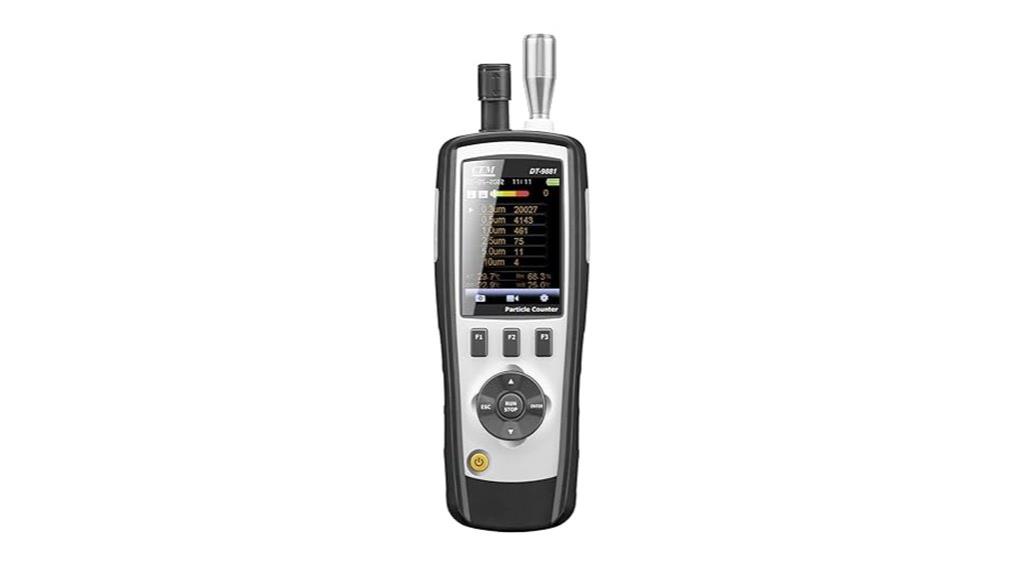
If you need a portable particle counter that combines advanced documentation features with precise measurements, the CEM T.ax Particle Counter with TFT Display and Camera is an excellent choice. It features a 2.8-inch color LCD display, supports data export via USB, and has a built-in camera for real-time documentation. Using Mie-scattering, it detects seven particle sizes simultaneously, up to 2 million particles per cubic foot, making it ideal for HVAC, cleanrooms, and air quality testing. Its reliable laser sensor ensures accuracy, while storage for 5,000 records and calibration certification guarantee dependable results. Plus, its extensive accessories and 12-month warranty make it a user-friendly, dependable instrument.
Best For: professionals conducting air quality assessments, HVAC testing, or cleanroom verification who need precise particle measurement combined with real-time documentation and data management.
Pros:
- Supports simultaneous detection of seven particle sizes with high accuracy using Mie-scattering technology
- Equipped with a built-in camera and TFT display for real-time documentation and easy data visualization
- Stores up to 5,000 records with straightforward data export via USB, ensuring reliable data management
Cons:
- May be relatively expensive compared to simpler particle counters lacking documentation features
- The device’s size and complexity might require some training for optimal use
- Limited to 2.8-inch display, which may be small for extensive data review on-site
PMS5003 Laser Air Quality Sensor
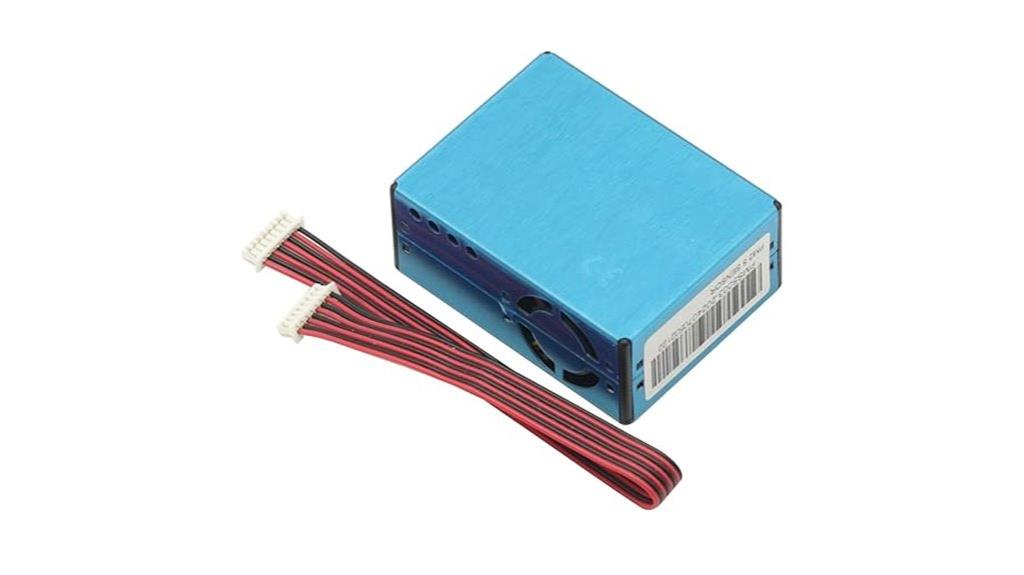
In the domain of air quality monitoring, the PMS5003 Laser Air Quality Sensor stands out for its high-precision laser scattering technology, making it an excellent choice for environmental professionals and researchers who need accurate particulate matter data. It measures digital PM concentrations, providing real-time information on particle mass and number per unit volume. The sensor’s laser scattering principle allows for precise detection of particle size and concentration. Its compact design and digital output enable seamless integration into various monitoring devices. I find it ideal for applications like pollution control, environmental assessment, and health initiatives, thanks to its reliability and ease of use.
Best For: environmental professionals, researchers, and developers seeking high-precision, real-time particulate matter monitoring for air quality assessment and pollution control.
Pros:
- High accuracy and reliability in detecting PM concentrations
- Digital output for straightforward integration into various systems
- Compact design suitable for diverse environmental monitoring applications
Cons:
- May require calibration for specific environmental conditions
- Potential sensitivity to dust or dirt on optical components
- Cost may be higher compared to less advanced sensors
Seco-Larm Twin Photobeam Detector with Laser Beam Alignment
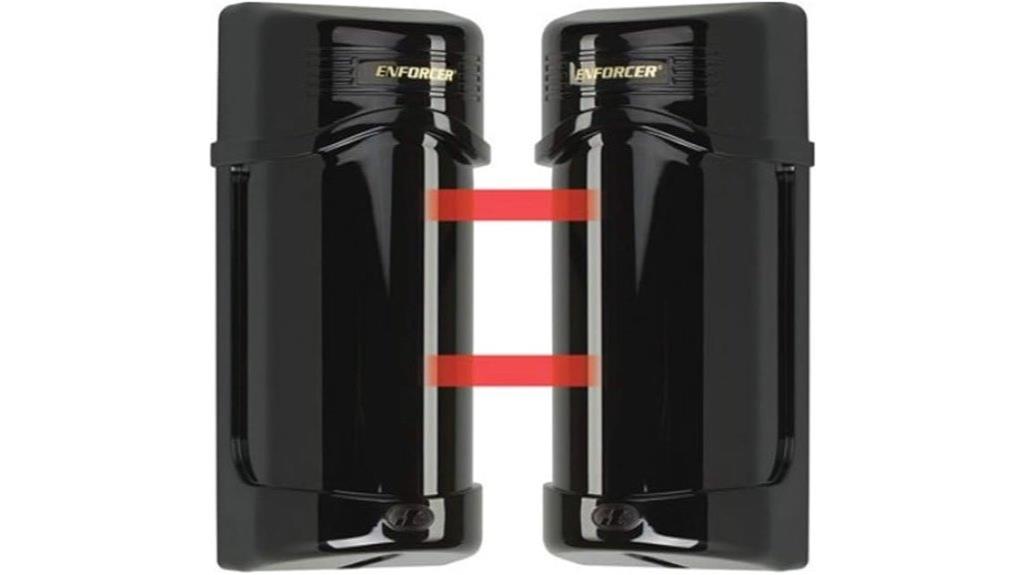
The Seco-Larm Twin Photobeam Detector with Laser Beam Alignment stands out for its precise laser alignment system, making it an excellent choice for security professionals who need reliable perimeter detection. Its twin beams minimize false alarms caused by environmental factors like rain, snow, or leaves. The built-in laser alignment simplifies installation, ensuring quick setup and accurate positioning. With weatherproof casing, anti-frost features, and LEDs indicating status, it’s designed for durability in outdoor conditions. Operating over long ranges—up to 90 meters outdoors—it offers flexible, secure perimeter protection. This detector combines ease of use with robust performance, making it ideal for a wide range of security applications.
Best For: security professionals and property owners seeking reliable outdoor perimeter detection with easy installation and minimal false alarms.
Pros:
- Precise laser beam alignment simplifies setup and ensures accurate positioning
- Twin beams reduce false alarms caused by environmental disturbances like rain, snow, or leaves
- Weatherproof casing with anti-frost features ensures durability in outdoor conditions
Cons:
- Limited sensing range indoors (60m) compared to outdoor range (90m)
- Requires a continuous power source; no battery backup option available
- Installation may require mounting brackets and careful alignment for optimal performance
Temtop PMD371 Particle Counter for Air Quality Monitoring
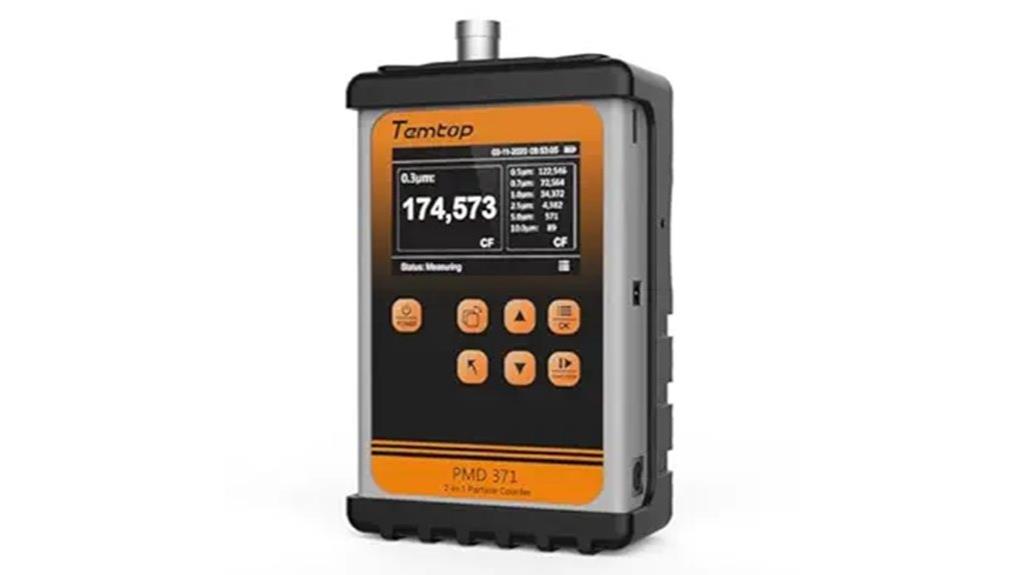
Designed for professionals who require precise and all-encompassing air quality monitoring, the Temtop PMD371 Particle Counter stands out with its dual-detection technology. It measures particle concentrations across PM1, PM2.5, PM4, PM10, and TSP, while also counting particles from 0.3μm to 10μm. Built with high-performance sensors and advanced Mie-scattering principles, it guarantees accurate results aligned with ISO 21501 and NIST standards. Its robust metal body, 8GB storage, and versatile data transfer options make it ideal for demanding environments like laboratories and cleanrooms. With a user-friendly display and long battery life, it’s a reliable tool for exhaustive air quality analysis.
Best For: professionals in laboratories, cleanrooms, and industrial environments seeking precise, comprehensive air quality monitoring and particle analysis.
Pros:
- Dual-detection technology offers simultaneous measurement of particle concentrations and counts across multiple size ranges.
- High accuracy and reliability, compliant with ISO 21501 and NIST standards, thanks to advanced sensors and engineering.
- Large 8GB internal storage and versatile data transfer options facilitate efficient data management and analysis.
Cons:
- The device’s size and professional features may require user training for optimal operation.
- Higher cost compared to simpler particle counters, which may be a consideration for budget-conscious users.
- Battery life of approximately 8 hours might necessitate frequent recharging during extended use.
Dust Particle Counter, 3-Channel Air Quality Monitor (PM0.3/2.5/10 μm)
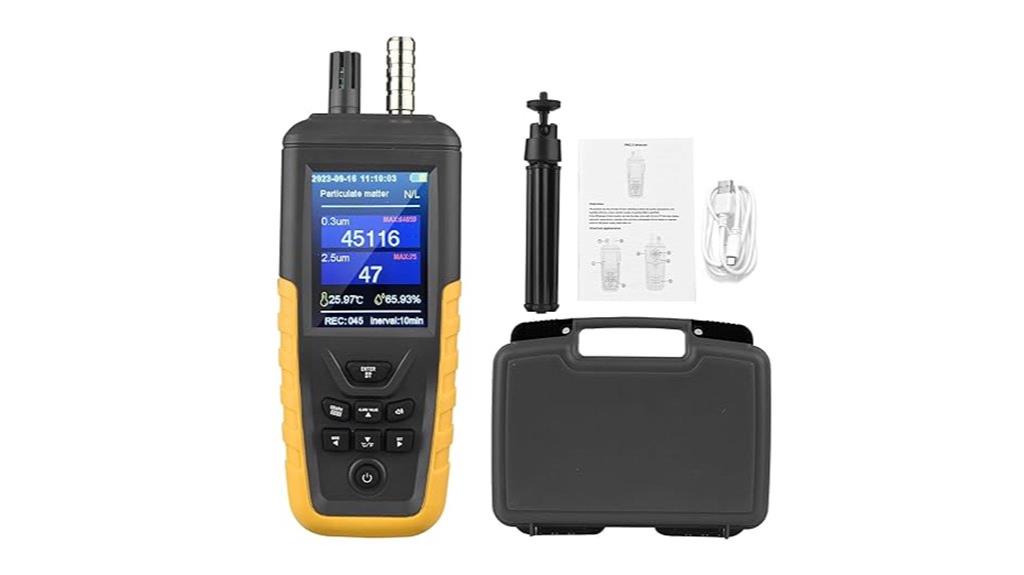
If you’re seeking a reliable air quality monitor for precise particle detection, the Dust Particle Counter with 3-channel measurement stands out. Using laser scattering technology, it accurately detects particles from 0.3μm to 10μm, including PM2.5, with a range of 0-1000μg/m³ and an accuracy of ±12μg/m³. It also measures temperature, humidity, and AQI for extensive indoor air quality assessment. The 3.2-inch HD display shows real-time data clearly, while storage for up to 999 datasets allows trend analysis. Its portable design, with a rechargeable battery lasting around 10 hours, makes it ideal for diverse environments and detailed pollution tracking.
Best For: indoor environment professionals, health-conscious individuals, and industries requiring precise air quality monitoring and pollution trend analysis.
Pros:
- High accuracy laser scattering technology for precise particle detection from 0.3μm to 10μm.
- Supports comprehensive air quality metrics including PM2.5, temperature, humidity, and AQI.
- Portable with long battery life (around 10 hours) and easy data management via USB and large storage capacity.
Cons:
- May be more expensive than basic air quality monitors due to advanced features.
- Requires calibration for optimal accuracy over extended use.
- Limited to indoor environments; not suitable for outdoor air quality measurement.
Temtop PMD371 Portable Particle Counter for Cleanrooms and Labs
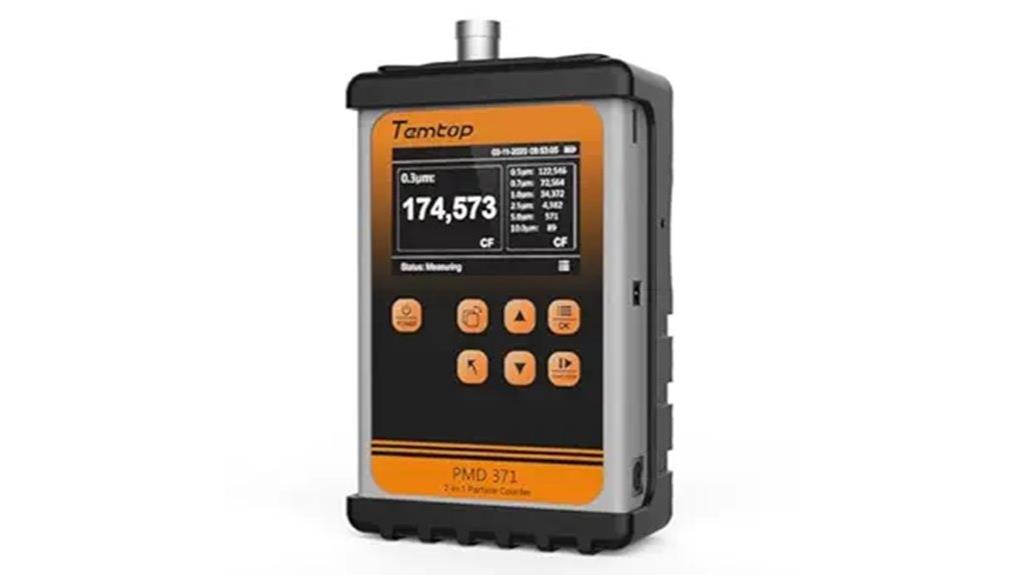
For professionals working in cleanrooms, laboratories, or sensitive industrial settings, the Temtop PMD371 Portable Particle Counter stands out due to its dual-detection technology, which measures both particle concentration and count across multiple size ranges. It provides detailed particulate analysis with high accuracy, thanks to advanced Mie-scattering principles and a professional-grade sensor. The device features a German Furgut pump with a 2.83L/min flow rate, complying with ISO 21501 and NIST standards. Its large 4-inch display and extensive data storage make monitoring easy, while the durable metal design and 8-hour battery ensure reliable performance in demanding environments.
Best For: professionals in cleanrooms, laboratories, and sensitive industrial environments seeking accurate, comprehensive particulate analysis.
Pros:
- Dual-detection technology measures both particle concentration and count across multiple size ranges for detailed analysis.
- High accuracy with advanced Mie-scattering principles and compliance with ISO 21501 and NIST standards.
- Durable full metal construction, extended 8-hour battery life, and extensive data storage for reliable, long-term use.
Cons:
- May be relatively expensive compared to simpler particle counters.
- The device’s advanced features and data management options could require some technical training to maximize utility.
- Portability could be limited by its size and weight due to robust metal construction.
Factors to Consider When Choosing Laser Particle Size Analyzers
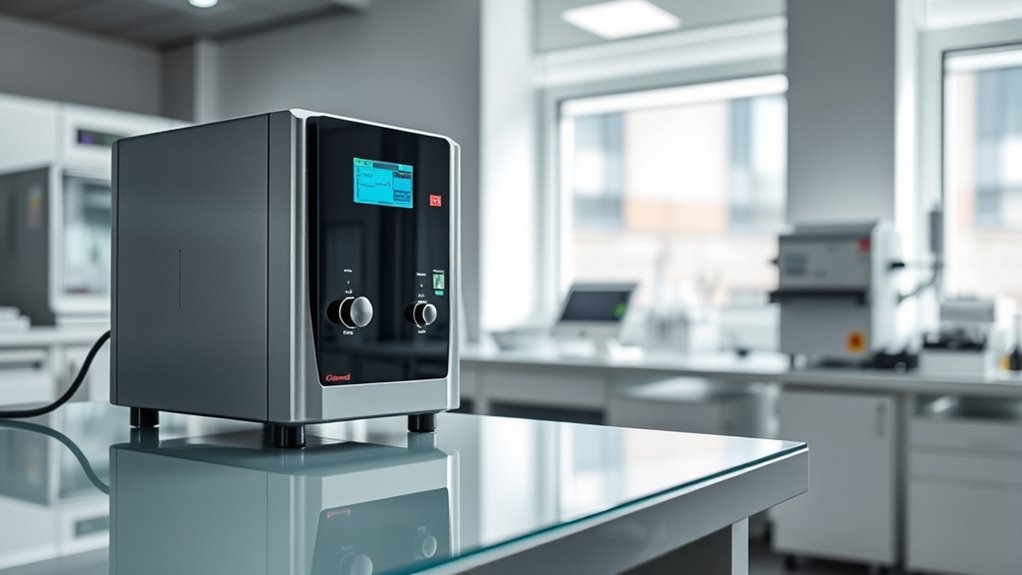
When selecting a laser particle size analyzer, I focus on key factors like measurement range and precision to guarantee it fits my needs. Particle size resolution, data storage, and calibration options also influence how effectively I can use the device. Finally, I consider how easy it is to operate, so I can get accurate results without unnecessary hassle.
Measurement Range Precision
Choosing the right laser particle size analyzer hinges on understanding its measurement range and precision. A broader measurement range allows me to detect both very small and larger particles, making the device versatile for various applications. High precision is essential for accurate results, achieved through advanced laser scattering technology and sensitive detectors that minimize measurement uncertainty. Fine resolution helps distinguish between particles with close diameters, such as 0.3μm and 0.5μm. However, the accuracy of measurements can be influenced by the laser wavelength and the quality of optical components. Consistent accuracy also depends on proper calibration and regular maintenance to prevent sensor drift over time. Evaluating these factors ensures reliable, precise particle size measurements tailored to my specific needs.
Particle Size Resolution
Particle size resolution determines how accurately a laser particle size analyzer can distinguish between particles with very similar diameters. A higher resolution means I can detect subtle size differences, which enhances measurement accuracy—especially important for applications like pharmaceuticals or cleanroom testing. Resolution is usually expressed in micrometers (μm) and reflects the analyzer’s ability to identify small variations within a sample. Achieving finer resolution depends on factors such as laser wavelength, sensor sensitivity, and data processing algorithms. When selecting an analyzer, I prioritize devices with superior resolution to ensure precise, detailed particle size distribution data. This allows me to differentiate particles that are very close in size, providing confidence in my results and supporting rigorous quality control or research requirements.
Data Storage Capacity
Having sufficient data storage capacity is essential because it allows me to log extensive particle size and air quality data over long periods without constant data transfers. Devices with larger memory, such as 8GB or more, can store millions of data points, enabling detailed trend analysis and comprehensive historical records. This is crucial for compliance, troubleshooting, and research. Storage options often include internal memory and external export methods like USB drives or RS-485 connections, which influence overall capacity. Limited storage means I’d need frequent data offloading, risking interruptions in continuous monitoring and reducing data resolution. Consequently, choosing an analyzer with ample storage ensures I can maintain constant data collection, analyze long-term patterns, and avoid disruptions, making it a fundamental factor in selecting the right instrument.
Calibration Options Available
Calibration options are a critical factor because they directly influence the accuracy and reliability of a laser particle size analyzer. I look for devices that offer flexible calibration methods, such as manual, automatic, or factory calibration, to suit different operational needs. Some analyzers support periodic calibration using certified reference standards, helping maintain measurement precision over time. It’s important that the calibration procedures involve comparing measurements against known particle size standards or reference instruments to verify accuracy. I also check whether the device provides built-in calibration functions or requires external kits. Regular calibration, whether manual or automatic, is essential to ensure consistent, trustworthy results. Choosing an analyzer with reliable calibration options helps avoid measurement errors and guarantees high-quality data.
Ease of Operation
Choosing a laser particle size analyzer that’s easy to operate can make a significant difference in your testing workflow. I look for intuitive controls like simple buttons or touchscreens that allow for quick learning and straightforward use. A clear, real-time display of measurement results and status indicators helps me monitor progress and troubleshoot efficiently, even without extensive technical expertise. Automated calibration and self-diagnostic features reduce manual adjustments, saving time and minimizing errors. User interfaces with step-by-step prompts or guided procedures further streamline operation and cut down on training. Additionally, a compact, ergonomic design with accessible ports and minimal setup requirements makes handling the device in different environments effortless. Ease of operation guarantees I get accurate results faster and with less frustration.
Durability and Portability
Durability and portability are crucial factors when selecting a laser particle size analyzer, especially if I plan to use it in challenging environments or across multiple locations. I look for models built with robust materials like metal or high-strength plastics that can withstand harsh conditions and frequent handling. Compact designs, lightweight construction—often under three pounds—and features like rechargeable batteries make field deployment easier. Protective features such as sealed casings and vibration-resistant components ensure long-term reliability, even in dusty or moist settings. Easy-to-carry designs with ergonomic handles or carrying cases simplify transportation. Importantly, the ability to operate independently on battery power and resist environmental factors like dust, moisture, and temperature changes are key indicators of a device’s durability and portability.
Connectivity Features
Connectivity features play an essential role in how effectively laser particle size analyzers can be integrated into existing systems and workflows. I look for options like USB, RS-485, Ethernet, or Wi-Fi, which allow seamless connection to monitoring systems and data networks. Advanced analyzers that support multiple data output formats make transferring and analyzing data across different platforms straightforward. Remote access capabilities are a bonus, enabling me to monitor and control the device from anywhere, boosting operational flexibility. Compatibility with external devices, such as PCs or data loggers, is crucial for continuous data recording and detailed post-analysis. Additionally, support for industry-standard communication protocols ensures reliable, secure data exchange, especially in complex industrial or research environments. These features streamline data management and improve overall efficiency.
Frequently Asked Questions
How Do Laser Particle Size Analyzers Differentiate Between Particle Shapes?
Laser particle size analyzers differentiate between particle shapes by analyzing how particles scatter laser light. I observe variations in scattering patterns, which reveal shape information, especially when combined with algorithms that interpret the data. This method helps me identify irregular, elongated, or spherical particles accurately. By examining these scattering patterns, I can determine shape characteristics, ensuring precise measurements for quality control, research, or industrial applications.
What Maintenance Is Required for Long-Term Accuracy?
To keep my laser particle size analyzer accurate over time, I regularly clean the optical components to prevent dust and dirt buildup. I also calibrate the device using standard reference materials, check for software updates, and guarantee the instrument is properly aligned. Additionally, I monitor environmental conditions like temperature and humidity, as they can affect measurements. Consistent maintenance helps me maintain precise, reliable results.
Can These Analyzers Detect Biological Particles Effectively?
Did you know that laser particle size analyzers can detect particles as small as 0.1 micrometers? I can confirm they can effectively detect biological particles, especially with specialized configurations. These analyzers use specific wavelengths and detection techniques that enhance sensitivity to biological matter like bacteria or spores. I’ve seen them work well in labs focused on health, environmental, or pharmaceutical applications, providing accurate, rapid results for biological particle analysis.
How Do Environmental Conditions Affect Measurement Reliability?
Environmental conditions can considerably impact measurement reliability. I’ve seen that temperature fluctuations cause instrumental drift, while humidity can interfere with laser stability and particle dispersion. Dust and vibrations introduce noise and inaccuracies. To guarantee precise results, I always control environment factors, use proper calibration, and maintain a clean, stable setting. Staying vigilant about these conditions helps me get consistent, reliable particle size measurements every time.
Are Portable Models Suitable for Fieldwork and Outdoor Testing?
Absolutely, portable laser particle size analyzers are great for fieldwork and outdoor testing. I once took a compact model into a quarry, and it handled dust and vibrations surprisingly well—like a trusty compass in rough terrain. They’re designed for mobility, making measurements quick and accurate outside labs. As long as you follow proper calibration and handle environmental factors, these devices deliver reliable results on the go, just like their larger counterparts.
Conclusion
Choosing the right laser particle size analyzer is essential for accurate air quality assessments. Did you know that studies show that over 90% of indoor air pollution comes from particles smaller than 2.5 micrometers? This highlights the importance of selecting a device that can reliably detect these tiny particles. With the right analyzer, you’ll gain precise insights, helping you create safer, cleaner environments. Investing in quality measurement tools truly makes a difference in safeguarding health.
